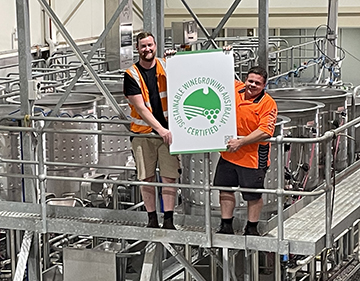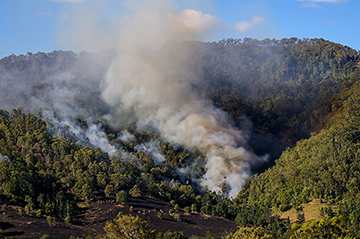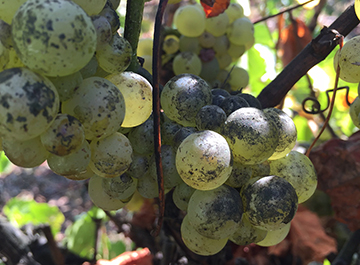Order the latest staff publications online
Accessing the latest AWRI publications is easy. Visit the AWRI Publications web page to:
- View the 10 most recent AWRI staff publications and order the articles online from the AWRI Library
- Search the staff publications database
- Read the full-text of ‘Technical Notes’ from Technical Review (PDF format)
- Read the full-text of ‘AWRI reports’ and ‘Vineyards of the world columns’ published in Wine & Viticulture Journal (PDF format)
- Read the full text of ‘Ask the AWRI columns’ published in Australian & New Zealand Grapegrower & Winemaker
The AWRI’s most recent publications are listed below.
2263 Mierczynska-Vasilev, A., Vasilev, A., Reilly, T., Bindon, K., Vasilev, K. Fluorescence sensing technology for the rapid detection of haze-forming proteins in white wine. Food Chem. 374: 131770; 2022.
2264 Cruz, F.C.S., Habili, N., Wu, Q., Sagarino, R.B., Randles, J.W. Detection of ‘Candidatus Phytoplasma luffae’ in sponge gourd, bitter gourd, and bamboo from Laguna in Luzon, Philippines. Philipp. Agric. Sci. 104(2): 181-185; 2021.
2265 Barter, S., Siebert, T., Bramley, R., Herderich, M., Krstic, M. Better late than never: the formation of distinctive pepper aromas in cool-climate Shiraz. Wine Vitic. J. 37(1): 35-37; 2022.
2266 Dry, P. Inzolia. Wine Vitic. J. 37(1): p. 68; 2022.
2267 Krstic, M. The Australian Wine Research Institute: Annual Report 2021. Aust. N.Z. Grapegrower Winemaker (695): 88-91; 2021.
2268 Krstic, M.P., Culbert, J.A., Parker, M., Herderich, M.J. Smoke taint and climate change. Reynolds, A.G. (ed.) Managing wine quality. Volume 1: Viticulture and wine quality. 2nd Edition: Cambridge, MA ; Oxford, UK : Woodhead Publishing. (Chapter 17.4): 763-778; 2021.
2269 Nordestgaard, S. Beyond Baumé rounds and tank dips. Aust. N.Z. Grapegrower Winemaker (695): 76-81; 2021.
2270 Schmidt, S., Holdstock, M. Ask the AWRI: Aerating red ferments. Aust. N.Z. Grapegrower Winemaker (695): 53-54; 2021.
2271 Wilkinson, K.L., Ristic, R., McNamara, I., Loveys, B., Jiang, W., Krstic, M. Evaluating the potential for smoke from stubble burning to taint grapes and wine. Molecules 26(24): 7540; 2021.
2272 Espinase Nandorfy, D., Siebert, T., Watson, F., Keast, R., Francis, I.L. Understanding the interactive effects of volatile compounds contributing to ‘stone fruit’ aroma nuances in white wines. Aust. J. Grape Wine Res. doi: 10.1111/ajgw.12540 : 1-15; 2021.
2273 Onetto, C.A., Costello, P.J., Kolouchova, R., Jordans, C., McCarthy, J. Schmidt, S.A. Analysis of transcriptomic response to SO2 by Oenococcus oeni growing in continuous culture. Microbiol. Spectr. 9(2): e01154-21; 2021.
2274 Sawyer, S., Longo, R., Solomon, M., Nicolotti, N., Westmore, H., Merry, A., Gnoinski, G., Ylia, A., Dambergs, R., Kerslake, F. Autolysis and the duration of ageing on lees independently influence the aroma and composition of traditional method sparkling wine. Aust. J. Grape Wine Res. 28(1): 146-159; 2022.
2275 Villarreal, P., Villarroel, C., O’Donnell, S., Agier N., Quintero-Galvis, J., Peña, T., Nespolo, R., Fischer, G., Varela, C., Cubillos, F. Late Pleistocene-dated divergence between South Hemisphere populations of the non-conventional yeast L. cidri. Authorea. DOI: 10.22541/au.164182824.45750907 /v1: 2022.
2276 Cordingley, B. Ask the AWRI: Sacrificial yeast cultures for SO2 reduction. Aust. N.Z. Grapegrower Winemaker (696): 52-53; 2022.
2277 Keast, R., Liem, G., Francis, L., Nandorfy, D. Food files: unravelling the flavour of white wine. Food Aust. 74(1): 30-31; 2022.
2278 Dixon, R. Ask the AWRI: How to tame an unruly canopy. Aust. N.Z. Grapegrower Winemaker (697): 54-57; 2022.
2279 Coulter, A., Baldock, G., Parker, M., Hayasaka, Y., Francis, I.L., Herderich, M. Concentration of smoke marker compounds in non-smoke-exposed grapes and wine in Australia. Aust. J. Grape Wine Res. doi: 10.1111/ajgw.12543 : 1-16; 2022.
2280 Nordestgaard, S. Measuring stinky ferments in situ. Aust. N.Z. Grapegrower Winemaker (697): 62, 64-68, 70-71; 2022. |








